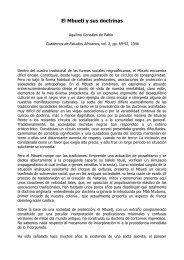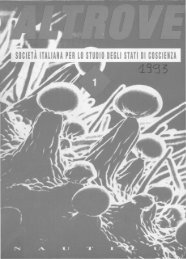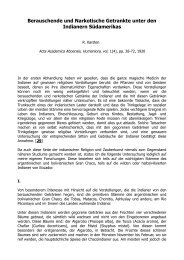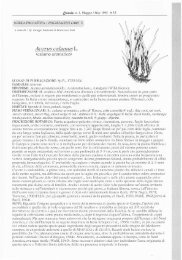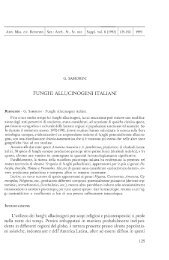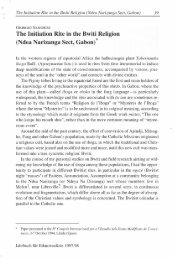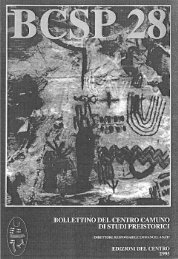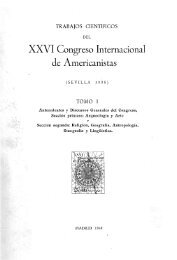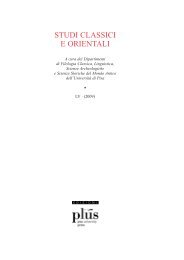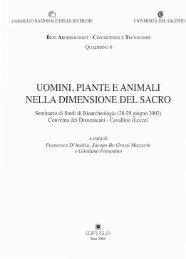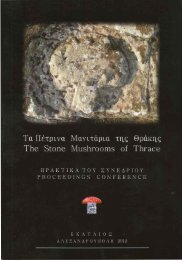Gli "alberi-fungo" nell'arte cristiana - Giorgio Samorini Network
Gli "alberi-fungo" nell'arte cristiana - Giorgio Samorini Network
Gli "alberi-fungo" nell'arte cristiana - Giorgio Samorini Network
Create successful ePaper yourself
Turn your PDF publications into a flip-book with our unique Google optimized e-Paper software.
GIORGIO SAMORINI<br />
93 Eleusis, n.s., n. 1, 1998<br />
In un altro mosaico, proveniente dalla regione tunisina<br />
di Béja, datato al V-VI secolo e conservato presso il<br />
Museo del Bardo di Tunisi (fig. 7, cfr. FANTAR 1995:92-3) è<br />
presente un albero-fungo che ricorda quelli di Ounai"ssia. Il<br />
mosaico raffigura la scena mitologica greca di Achille che<br />
viene educato da Chirone,<br />
il più saggio dei Centauri,<br />
alla caccia al cervo. Nella<br />
parte inferiore destra è raffigurata<br />
una Chimera.<br />
Attorno alle figure di<br />
Achille e di Chirone sono<br />
rappresentati quattro vegetali<br />
aventi la medesima<br />
forma e che, ad un'attenta<br />
osservazione, possono essere<br />
riconosciuti come <strong>alberi</strong>fungo.<br />
Tre di questi, per<br />
probabili esigenze di spazio,<br />
sono costituiti ciascuno<br />
da due funghi, mentre il<br />
Iy placed beside the Tree of Life; it might be considered a<br />
variant of a scheme which also originates in the Middle<br />
East and dates back to remotest antiquity. Here we have the<br />
two animals and three Trees or Plants of Life which are<br />
usually the same as each other, one between the two animaIs<br />
and the other two<br />
behind them. A fine example<br />
comes from the Mycenean<br />
gold ring in fig. 6, in which<br />
three trees or plants are<br />
combined with two quadrupeds,<br />
apparently steinboks.<br />
During the last stage of<br />
absorption of this artistic<br />
scheme in Christian art (i.e.<br />
its full transformation into a<br />
"truly" Christian symbol)<br />
we may note the recurring<br />
image of the two ani mais<br />
combined with one or more<br />
crosses. As we have already<br />
quarto è costituito da tre Fig. 7 - Mosaico romano, Bé.ia, Tunisia. V-VI secoli d.C. indicated, the Trees of Life<br />
funghi. Nelle fronde-cap<br />
Roman mosaic, Béja, Tunisia. 5th-6th C AD<br />
become the symbol of the<br />
pello di tutti questi <strong>alberi</strong>fungo<br />
sono disegnati con<br />
un differente colore delle linee che ricordano le "striature"<br />
degli <strong>alberi</strong>-fungo di Ouna'issia e che, in alcuni casi, fuoriescono<br />
di un poco dal bordo inferiore della fronda-cappello.<br />
V'è chi ha chiamato questo tipo di albero-fungo "albero<br />
con la fronda a forma di medusa" (RIOU 1992). In una lettura<br />
micologica, quelle linee che fuoriescono dal bordo del<br />
cappello ricordano quei filamenti che ornano il bordo del<br />
cappello di diverse specie di funghi - psicoattivi e non - del<br />
tipo Panaeolus.<br />
Ricordo che la figura mitologica del Centauro era già<br />
stata posta in associazione con i funghi psicoattivi da<br />
ROBERT GRAVES, nel suo saggio Food for Centaurs (1960,<br />
Incontriamo <strong>alberi</strong><br />
fungo simili a quelli di<br />
Fig. 8 - Abbazia di Saint<br />
Savin-sur Gartempe, Vienne,<br />
Francia centrale<br />
Abbey ofSainl-Savinsur-Gartempe,<br />
Vienne, central France<br />
cfr. 1994), offrendo<br />
tuttavia argomentazioni<br />
superficiali e, forse,<br />
anche un poco fantasiose.<br />
FANTAR (1995:92),<br />
discutendo del mosaico<br />
di Béja, opera di<br />
artisti cristiani che<br />
recuperavano simboli e<br />
mitologie pagane, sottolinea<br />
il fatto ch' esso<br />
risale all' epoca delle<br />
eresie e delle lotte fratricide<br />
fra i differenti<br />
gruppi cristiani.<br />
Cross, once Christianized,<br />
and the three parts constituting<br />
many examples of a certain type of Tree of Life (e.g.<br />
in the Mycenean ring) become the three upper components<br />
of the Cross, the various stages of the "crucifixion" of the<br />
Tree of Life become evident in paleo-Christian art.<br />
The Ouna'issia mosaic represents a stage in the transition<br />
of this iconographic scheme: the two animals are symmetrical1y<br />
placed and are once more two (ochre-coloured<br />
and white-spotted) Cervidae; the tree placed between the<br />
animals has already completed its transformation into a<br />
"cross", and, below it, there is a Cantharos containing the<br />
Water of Life (at this stage, perhaps already considered the<br />
blood of Christ). We may al so note that the other two Trees<br />
of Life, placed behind the animals, have not yet been fully<br />
'crucified'. These two trees are mushroom-trees of a different<br />
kind than the Plaincourault one. Both feature the three<br />
cap-like fronds and, upon these, verticallines have been<br />
traced which we may consider "striations".<br />
In another 5th-6th century mosaic from the Béja<br />
region in Tunisia, housed in the Bardo Museum in Tunis<br />
(fig. 7, cf. FANTAR 1995:92-3), we find a mushroom-tree<br />
similar to the Ounai"ssia example. This mosaic represents a<br />
Greek mythological scene in which Achilles receives<br />
instruction from Chiron, the wisest of the Centaurs, on<br />
deerhunting. A Chimera is presented in the lower left corner.<br />
Achilles and Chiron are surrounded by four plants of<br />
the same shape, and on careful observation we may consider<br />
them mushroom-trees. Probably for reasons of space,<br />
three of these are composed of two mushrooms but the<br />
fourth has three. Each of the frond-caps presents lines in<br />
various colours which remind us of the "striations" encoun



